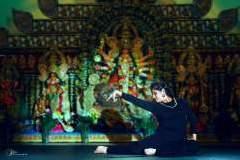Bharathanatyam basics 9 month course 75 hours total
Bharatanatyam is a classical Indian dance form that originated in the state of Tamil Nadu. It is known for its intricate footwork, expressive gestures, and intricate body movements. The elements you mentioned are indeed fundamental to Bharatanatyam. Here's a brief explanation of each:
Thattadavu: This refers to a series of rhythmic steps that are performed on the spot. Thattadavu helps develop coordination, balance, and control of the feet.
Nattadavu: Similar to Thattadavu, Nattadavu involves a combination of rhythmic steps but with some movements across space. It further enhances footwork and agility.
Paraval adavu: Paraval adavu involves graceful movements in diagonal patterns. It emphasizes the extension of the body and the flow of movement.
Kuduthmittu adavu: This adavu focuses on intricate footwork and involves a combination of fast and slow steps.
Kuthadavu: Kuthadavu involves rhythmic jumping movements and footwork patterns, adding a dynamic element to the dance.
Kuduth thattavu: Kuduth thattavu combines elements of Thattadavu and Nattadavu, incorporating different rhythmic patterns and movements.
Tha thei tham adavu: Tha thei tham adavu is a complex footwork pattern that involves rhythmic synchronization of foot movements.
Panchanadai: Panchanadai is a sequence of five rhythmic patterns performed in a particular order. It requires precision and control over footwork.
Mandi adavu: Mandi adavu focuses on movements performed in a sitting position. It involves various gestures and expressions.
Theerumanam adavu: Theerumanam adavu involves movements that imitate a swinging motion. It requires coordination between the upper body and feet.
Hastas: Hastas are hand gestures that convey specific meanings and emotions. Asamyutha hasthas are single-hand gestures, while samyutha hasthas are gestures performed with both hands.
Viniyogas: Viniyogas refer to the practical application of hastas in dance compositions. Pathaka, tripathaka, and ardha pathaka are specific hand formations used in different contexts.
Bhedas: Drishti bhedas involve different eye movements and positions, which enhance the expressiveness and aesthetic appeal of the dance.
These are some of the foundational elements of Bharatanatyam that you will learn during a 9-month course. Remember, Bharatanatyam is a comprehensive art form that combines these elements with music, rhythm, facial expressions, and storytelling to create a rich and captivating dance experience. Enjoy your journey into Bharatanatyam!






